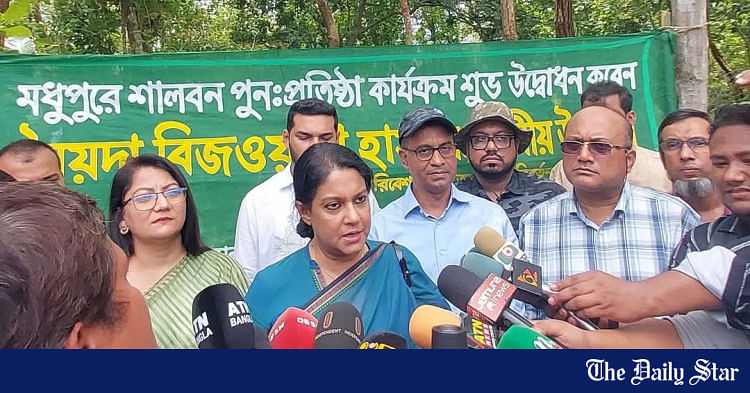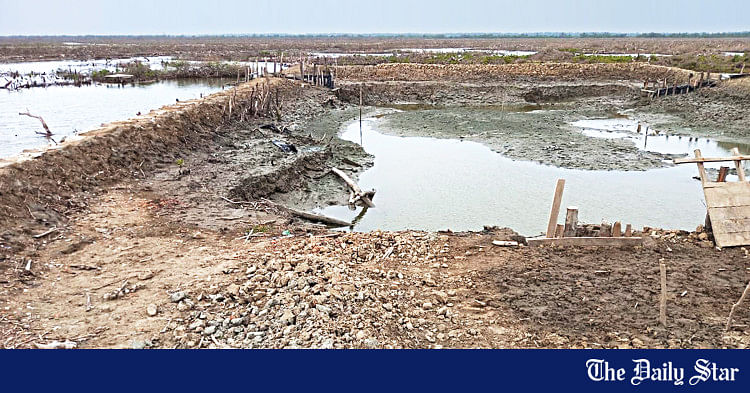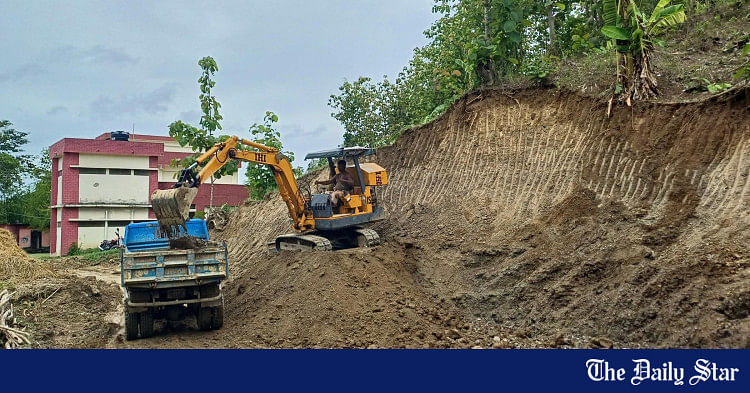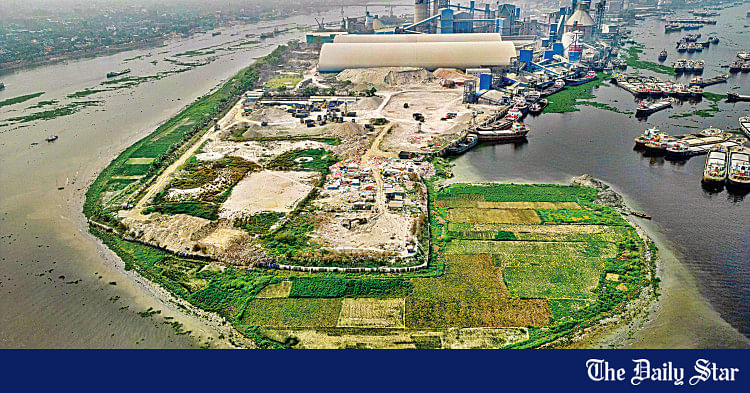- Copy to clipboard
- Thread starter
- #406
Saif
Senior Member
- Messages
- 14,207
- Reaction score
- 7,468
- Origin

- Residence

- Axis Group


When rivers weep in silence
RIVERS have for long been Bangladesh’s lifeblood — irrigating paddy fields at dawn, carrying timber and trade by noon, and quenching hearths and homes each evening. Yet today, these ancient arteries lie poisoned and diminished: the Buriganga is bathed in industrial effluent, the Sitalakhya reeks...
 www.newagebd.net
www.newagebd.net
When rivers weep in silence
Joydeep Chowdhury 18 May, 2025, 00:00

RIVERS have for long been Bangladesh’s lifeblood — irrigating paddy fields at dawn, carrying timber and trade by noon, and quenching hearths and homes each evening. Yet today, these ancient arteries lie poisoned and diminished: the Buriganga is bathed in industrial effluent, the Sitalakhya reeks of rust and neglect and the Turag is reduced to a choked whisper of its former breadth. We once invoked their names in song and myth. Now we invoke them in courtrooms.
In 2019, the High Court delivered a groundbreaking judgement. It declared the River Turag, and, by extension, all rivers, as living entities and legal persons. The Appellate Division upheld the ruling, establishing it as national law. The National River Conservation Commission was appointed in loco parentis, Latin for ‘in the place of a parent’, and is legally responsible for protecting these rivers, speaking on their behalf, and ensuring their rights are enforceable against both private corporations and public agencies.
This decision was not just a legal ruling; it was a poetic moment. It offered a river the dignity long afforded to banks and corporations. And yet, over half a decade later, the question floats unanswered: has the river’s life improved? The Buriganga still runs thick with industrial discharge, its waters as dark as night. The Sitalakhya smells of corrosion and abandonment. The Turag, once the inspiration for personhood, now flows like a wounded vein — narrowed, choked, silenced.
We gave rivers a voice in the courtroom but left them mute in the real world.
Where water becomes bloodline
TO UNDERSTAND the betrayal, we must first remember what rivers mean to this land. Bangladesh is not simply a country with rivers. It is a country made of them.
More than 700 rivers flow across this delta like ancestral threads, stitching together the nation’s geography, economy, memory, and soul. Rivers are not beside us; they are beneath us, within us. Our rice fields bow to their seasonal rhythms. Our fishermen trace their dreams along their channels. Our poems, songs and proverbs speak of the Padma, the Meghna and the Jamuna, not as water bodies but as mothers, lovers and warriors.
Rivers birthed our settlements. They fed our revolts. They carried our tears and our trade. Our language is moist with their memory — nadir mata chhila meyeti, she was like a river, as we say of a woman. They are metaphors and matter. They are flow and form.
When we say a river is dying, we are not speaking of water. We are speaking of lineage. We are speaking of ourselves.
Hollow inheritance of rights
LEGAL personhood is not a decorative label. It means an entity is granted rights similar to those of a human or a corporation. It can file and receive lawsuits. It can seek redress. This concept gained momentum in New Zealand when the River Whanganui received guardians who represent it in court and parliament.
In Bangladesh, however, river personhood was declared without such a scaffold. The rights exist in theory, but the river has no lawyer, no budget, and no standing. Factories still bleed toxins into their heart. Developers still gnaw away at its banks. Politicians still offer protection to the predators.
We handed the rivers a constitution, but not a conscience. We gave them a name, but not a backbone.
The National River Conservation Commission, declared the guardian of the rivers, cannot file criminal complaints independently. It cannot enforce eviction orders. It cannot compel factories to change or ministries to act. It relies on fragile cooperation from overlapping and often complicit government agencies. This process is not guardianship. This is ceremonial witnessing. A parent who cannot protect their child is not truly a parent. A guardian who cannot raise a voice in court or break a concrete slab from a riverbank is no guardian at all.
Symbolism, not stewardship
BANGLADESH’S personhood ruling has been cited in global law reviews and praised at conferences. But what has it achieved at home? The Buriganga’s breath grows thinner by the year. Untreated urban discharge pollutes the Karnaphuli. The Meghna swells with plastic, foam, and pesticide.
Symbolism without infrastructure is cruelty with flair. We have clothed our rivers in law’s finest language and then left them to die in silence.
A parallel unfolded in India in March 2017, when Uttarakhand’s High Court declared in Mohammad Salim v State of Uttarakhand that the Ganges and Yamuna were ‘living persons,’ appointing state officials in loco parentis to defend their rights. Weeks later, however, the Supreme Court stayed the order, citing its overreach and the absence of legislative authority, leaving both sacred rivers to continue bleeding untreated sewage and industrial waste. This legal mirage reveals that personhood in the abstract cannot heal poisoned waters; only a clear legislative framework, budgeted enforcement, and genuine guardianship can.
Ritualising rivers
THIS legal spectacle has left our rivers mere stage props. We have mastered lofty proclamations — granting personhood in courtrooms, convening seminars, and publishing glossy reports — but failed at real stewardship. Judges may declare rivers ‘legal persons,’ yet the agencies tasked with protecting them often lack sufficient funds, independence, and authority. A guardian without power is nothing more than an empty shell.
Our personhood ruling was a splendid ceremony: the law clothed rivers in sanctity but let them drown beneath concrete embankments and factory effluent. We extol ‘living entities’ while allowing the same encroachments, illegal discharges, and sand-mining that halve their breadth. Without a firm legislative framework — clear statutes defining guardians’ powers and enforceable remedies — our rivers remain ghosts: honoured in name, abandoned in reality.
True guardianship needs more than words. It demands funded enforcement units free to file suit, dedicated river tribunals to hear pollution cases, and empowered community stewards to act when a river’s health falters. Otherwise, personhood is a poem recited to a corpse — beautiful in theory, lifeless in practice.
Illusion of equivalence
BORROWED legal models such as Ecuador’s constitutional nature rights and New Zealand’s Maori guardianship do not translate neatly into Bangladesh’s socio-legal context. We lack the legislative follow-through, the political will, and the cultural respect for law that such transformations demand. Our rivers do not need foreign costumes. They need local custodians: boatmen, farmers, poets, and local councils — those who understand the rhythm of monsoon and silt, who weep when a river recedes.
The rivers may be ‘legal persons,’ but who will act on their behalf? Who will file the lawsuit when a textile plant dumps mercury into a canal? Who will attend court, pay the legal fees, and gather evidence? Without a river rights act, a law clearly defining legal standing, funding, and procedural recourse, the verdict means little. Justice that exists only in a judge’s chamber is no justice at all.
The interim government’s silence exacerbates the present situation. Without direct electoral pressure, it is reasonable to assume that this is the ideal time to act decisively and establish long-overdue ecological accountability. Nonetheless, the temporary administration has maintained a disconcerting quiet. The lack of communication from the environmental adviser’s office is notably unexpected, considering her established reputation as an environmentalist. Her public credentials include decades of advocacy, numerous accolades, and international recognition. At this pivotal juncture, her office has neither issued any significant statement nor articulated regulatory resistance to the industry’s ongoing damage to our rivers. This dilemma necessitates an evaluation. Why does a prominent environmentalist keep silent as rivers become polluted and disappear?
Bangladesh’s environmental statutes are deeply anthropocentric. They protect rivers only because humans need them. But what about the river as a being, an ecosystem, a cultural mirror? We must shift from the idea of rivers as usable things to rivers as co-inhabitants of this land. That shift is not legalistic. It is philosophical. And perhaps it’s the only path to survival.
Metaphor must bleed
WE CALLED the rivers people. That metaphor must now bleed into budgets, litigation, schoolbooks, and city planning. It must change how embankments are built, how factories are inspected, how water is treated, and how children are taught. If a river is a person, then poisoning it is murder. Encroachment must be considered theft. Then silence must be complicity.
The 2019 decision, affirmed by the Appellate Division, was not merely a ruling. It was a moment of national self-recognition. But the potential for change is hindered by policy paralysis. A law without legs is not a law — it is literature. Rivers once carved this land into civilisation. Now we must carve a civilisation that respects the rivers.
Let us not wait until our rivers become relics in textbooks and names of roads. Let us act not as landlords of nature but as children returned to their mother. If the law cannot cry with the rivers, then what is its voice for?
Joydeep Chowdhury is a lecturer in law at Sonargaon University, Dhaka. He is also an advocate at the district and sessions judges court, Dhaka.
Joydeep Chowdhury 18 May, 2025, 00:00
RIVERS have for long been Bangladesh’s lifeblood — irrigating paddy fields at dawn, carrying timber and trade by noon, and quenching hearths and homes each evening. Yet today, these ancient arteries lie poisoned and diminished: the Buriganga is bathed in industrial effluent, the Sitalakhya reeks of rust and neglect and the Turag is reduced to a choked whisper of its former breadth. We once invoked their names in song and myth. Now we invoke them in courtrooms.
In 2019, the High Court delivered a groundbreaking judgement. It declared the River Turag, and, by extension, all rivers, as living entities and legal persons. The Appellate Division upheld the ruling, establishing it as national law. The National River Conservation Commission was appointed in loco parentis, Latin for ‘in the place of a parent’, and is legally responsible for protecting these rivers, speaking on their behalf, and ensuring their rights are enforceable against both private corporations and public agencies.
This decision was not just a legal ruling; it was a poetic moment. It offered a river the dignity long afforded to banks and corporations. And yet, over half a decade later, the question floats unanswered: has the river’s life improved? The Buriganga still runs thick with industrial discharge, its waters as dark as night. The Sitalakhya smells of corrosion and abandonment. The Turag, once the inspiration for personhood, now flows like a wounded vein — narrowed, choked, silenced.
We gave rivers a voice in the courtroom but left them mute in the real world.
Where water becomes bloodline
TO UNDERSTAND the betrayal, we must first remember what rivers mean to this land. Bangladesh is not simply a country with rivers. It is a country made of them.
More than 700 rivers flow across this delta like ancestral threads, stitching together the nation’s geography, economy, memory, and soul. Rivers are not beside us; they are beneath us, within us. Our rice fields bow to their seasonal rhythms. Our fishermen trace their dreams along their channels. Our poems, songs and proverbs speak of the Padma, the Meghna and the Jamuna, not as water bodies but as mothers, lovers and warriors.
Rivers birthed our settlements. They fed our revolts. They carried our tears and our trade. Our language is moist with their memory — nadir mata chhila meyeti, she was like a river, as we say of a woman. They are metaphors and matter. They are flow and form.
When we say a river is dying, we are not speaking of water. We are speaking of lineage. We are speaking of ourselves.
Hollow inheritance of rights
LEGAL personhood is not a decorative label. It means an entity is granted rights similar to those of a human or a corporation. It can file and receive lawsuits. It can seek redress. This concept gained momentum in New Zealand when the River Whanganui received guardians who represent it in court and parliament.
In Bangladesh, however, river personhood was declared without such a scaffold. The rights exist in theory, but the river has no lawyer, no budget, and no standing. Factories still bleed toxins into their heart. Developers still gnaw away at its banks. Politicians still offer protection to the predators.
We handed the rivers a constitution, but not a conscience. We gave them a name, but not a backbone.
The National River Conservation Commission, declared the guardian of the rivers, cannot file criminal complaints independently. It cannot enforce eviction orders. It cannot compel factories to change or ministries to act. It relies on fragile cooperation from overlapping and often complicit government agencies. This process is not guardianship. This is ceremonial witnessing. A parent who cannot protect their child is not truly a parent. A guardian who cannot raise a voice in court or break a concrete slab from a riverbank is no guardian at all.
Symbolism, not stewardship
BANGLADESH’S personhood ruling has been cited in global law reviews and praised at conferences. But what has it achieved at home? The Buriganga’s breath grows thinner by the year. Untreated urban discharge pollutes the Karnaphuli. The Meghna swells with plastic, foam, and pesticide.
Symbolism without infrastructure is cruelty with flair. We have clothed our rivers in law’s finest language and then left them to die in silence.
A parallel unfolded in India in March 2017, when Uttarakhand’s High Court declared in Mohammad Salim v State of Uttarakhand that the Ganges and Yamuna were ‘living persons,’ appointing state officials in loco parentis to defend their rights. Weeks later, however, the Supreme Court stayed the order, citing its overreach and the absence of legislative authority, leaving both sacred rivers to continue bleeding untreated sewage and industrial waste. This legal mirage reveals that personhood in the abstract cannot heal poisoned waters; only a clear legislative framework, budgeted enforcement, and genuine guardianship can.
Ritualising rivers
THIS legal spectacle has left our rivers mere stage props. We have mastered lofty proclamations — granting personhood in courtrooms, convening seminars, and publishing glossy reports — but failed at real stewardship. Judges may declare rivers ‘legal persons,’ yet the agencies tasked with protecting them often lack sufficient funds, independence, and authority. A guardian without power is nothing more than an empty shell.
Our personhood ruling was a splendid ceremony: the law clothed rivers in sanctity but let them drown beneath concrete embankments and factory effluent. We extol ‘living entities’ while allowing the same encroachments, illegal discharges, and sand-mining that halve their breadth. Without a firm legislative framework — clear statutes defining guardians’ powers and enforceable remedies — our rivers remain ghosts: honoured in name, abandoned in reality.
True guardianship needs more than words. It demands funded enforcement units free to file suit, dedicated river tribunals to hear pollution cases, and empowered community stewards to act when a river’s health falters. Otherwise, personhood is a poem recited to a corpse — beautiful in theory, lifeless in practice.
Illusion of equivalence
BORROWED legal models such as Ecuador’s constitutional nature rights and New Zealand’s Maori guardianship do not translate neatly into Bangladesh’s socio-legal context. We lack the legislative follow-through, the political will, and the cultural respect for law that such transformations demand. Our rivers do not need foreign costumes. They need local custodians: boatmen, farmers, poets, and local councils — those who understand the rhythm of monsoon and silt, who weep when a river recedes.
The rivers may be ‘legal persons,’ but who will act on their behalf? Who will file the lawsuit when a textile plant dumps mercury into a canal? Who will attend court, pay the legal fees, and gather evidence? Without a river rights act, a law clearly defining legal standing, funding, and procedural recourse, the verdict means little. Justice that exists only in a judge’s chamber is no justice at all.
The interim government’s silence exacerbates the present situation. Without direct electoral pressure, it is reasonable to assume that this is the ideal time to act decisively and establish long-overdue ecological accountability. Nonetheless, the temporary administration has maintained a disconcerting quiet. The lack of communication from the environmental adviser’s office is notably unexpected, considering her established reputation as an environmentalist. Her public credentials include decades of advocacy, numerous accolades, and international recognition. At this pivotal juncture, her office has neither issued any significant statement nor articulated regulatory resistance to the industry’s ongoing damage to our rivers. This dilemma necessitates an evaluation. Why does a prominent environmentalist keep silent as rivers become polluted and disappear?
Bangladesh’s environmental statutes are deeply anthropocentric. They protect rivers only because humans need them. But what about the river as a being, an ecosystem, a cultural mirror? We must shift from the idea of rivers as usable things to rivers as co-inhabitants of this land. That shift is not legalistic. It is philosophical. And perhaps it’s the only path to survival.
Metaphor must bleed
WE CALLED the rivers people. That metaphor must now bleed into budgets, litigation, schoolbooks, and city planning. It must change how embankments are built, how factories are inspected, how water is treated, and how children are taught. If a river is a person, then poisoning it is murder. Encroachment must be considered theft. Then silence must be complicity.
The 2019 decision, affirmed by the Appellate Division, was not merely a ruling. It was a moment of national self-recognition. But the potential for change is hindered by policy paralysis. A law without legs is not a law — it is literature. Rivers once carved this land into civilisation. Now we must carve a civilisation that respects the rivers.
Let us not wait until our rivers become relics in textbooks and names of roads. Let us act not as landlords of nature but as children returned to their mother. If the law cannot cry with the rivers, then what is its voice for?
Joydeep Chowdhury is a lecturer in law at Sonargaon University, Dhaka. He is also an advocate at the district and sessions judges court, Dhaka.














